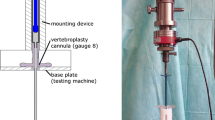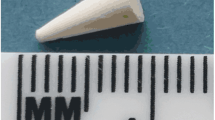Abstract
Acrylic bone cements are widely used for fixation of joint prostheses as well as for vertebral body augmentation procedures of vertebroplasty and balloon kyphoplasty, with the cement zone(s) being subjected to repeated mechanical loading in each of these applications. Although, in vertebroplasty and balloon kyphoplasty, the cement zone is exposed to mainly cyclical compressive load, the compressive fatigue properties of acrylic bone cements used in these procedures are yet to be determined. The purposes of the present study were to determine the compressive fatigue properties of a commercially available cement brand used in vertebroplasty, including the effect of frequency on these properties; to identify the cement failure modes under compressive cyclical load; and to introduce a screening method that may be used to shorten the lengthy character of the standardized fatigue tests. Osteopal\({^\circledR } \mathrm{V}\) was used as the model cement in this study. The combinations of maximum stress and frequency used were 50.0, 55.0, 60.0, 62.5 and 75.5 MPa at 2 Hz; and of 40.0, 55.0, 60.0, 62.5 or 75.5 MPa at 10 Hz. Through analysis of nominal strain-number of loading cycles results, three cement failure modes were identified. The estimated mean fatigue limit at 2 Hz (55.4 MPa) was significantly higher than that at 10 Hz (41.1 MPa). The estimated fatigue limit at 2 Hz is much higher than stresses commonly found in the spine and also higher than that for other acrylic bone cements tested in a full tension–compression fatigue test, which indicates that tension–compression fatigue testing may substantially underestimate the performance of cements intended for vertebroplasty. A screening method was introduced which may be used to shorten the time spent in performing compressive fatigue tests on specimens of acrylic bone cement for use in vertebral body augmentation procedures.





Similar content being viewed by others
References
ASTM (2009) ASTM F2118-03: Standard test method for constant amplitude of force controlled fatigue testing of acrylic bone cement materials
ASTM (2008) ASTM F 451-08: Standard specification for acrylic bone cement
Augat P, Link T, Lang TF et al (1998) Anisotropy of the elastic modulus of trabecular bone specimens from different anatomical locations. Med Eng Phys 20:124–131
Boelen EJH, Lewis G, Xu J et al (2008) Evaluation of a highly-radiopaque iodine-containing acrylic bone cement for use in augmentation of vertebral compression fractures. J Biomed Mater Res A 86A:76–88. doi:10.1002/jbm.a.31601
Charnley J (1960) Anchorage of the femoral head prosthesis to the shaft of the femur. J Bone Joint Surg Br 42-B:28–30
Cristofolini L, Minari C, Viceconti M (2000) A methodology and criterion for acrylic bone cement fatigue tests. Fatigue Fract Eng Mater Struct 23:953–957
Follet H, Viguet-Carrin S, Burt-Pichat B et al (2010) Effects of preexisting microdamage, collagen cross-links, degree of mineralization, age, and architecture on compressive mechanical properties of elderly human vertebral trabecular bone. J Orthop Res 29:481–488. doi:10.1002/jor.21275
Freitag TA, Cannon (1977) Fracture characteristics of acrylic bone cements. II. Fatigue. J Biomed Mater Res B 11:609–624
Galibert P, Deramond H, Rosat P, Le Gars D (1987) Preliminary note on the treatment of vertebral angioma by percutaneous acrylic vertebroplasty. Neurochirurgie 33:166–168
Gates EI, Carter DR, Harris WH (1983) Tensile fatigue failure of acrylic bone cement. J Biomech Eng 105:393–397
ISO (2008) ISO 16402. 1–12
Johnson JA, Provan JW, Krygier JJ et al (1989) Fatigue of acrylic bone cement—effect of frequency and environment. J Biomed Mater Res B 23:819–831
Kaiser T (1989) Highly crosslinked polymers. Prog Polym Sci 14:373–450
Keller TS (1994) Predicting the compressive mechanical behavior of bone. J Biomech 27:1159–1168
Köster U, Jaeger R, Bardts M et al (2013) Creep and fatigue behavior of a novel 2-component paste-like formulation of acrylic bone cements. J Mater Sci: Mater Med 24:1395–1406. doi:10.1007/s10856-013-4909-2
Krause WR, Grimes LW, Mathis RS (1988) Fatigue testing of acrylic bone cements: statistical concepts and proposed test methodology. J Biomed Mater Res-A 22:179–190
Kurtz SM, Villarraga ML, Zhao K, Edidin AA (2005) Static and fatigue mechanical behavior of bone cement with elevated barium sulfate content for treatment of vertebral compression fractures. Biomaterials 26:3699–3712. doi:10.1016/j.biomaterials.2004.09.055
Lewis G (2000) Relative roles of cement molecular weight and mixing method on the fatigue performance of acrylic bone cement: Simplex P versus Osteopal. J Biomed Mater Res-A 53:119–130
Lewis G (2003) Fatigue testing and performance of acrylic bone-cement materials: State-of-the-art review. J Biomed Mater Res B 66:457–486. doi:10.1002/jbm.b.10018
Lewis G (2006) Injectable bone cements for use in vertebroplasty and kyphoplasty: State-of-the-art review. J Biomed Mater Res B 76B:456–468. doi:10.1002/jbm.b.30398
Lewis G (2011) Viscoelastic properties of injectable bone cements for orthopaedic applications: State-of-the-art review. J Biomed Mater Res B 98B:171–191. doi:10.1002/jbm.b.31835
Lewis G, Austin GE (1994) Mechanical properties of vacuum-mixed acrylic bone cement. J Appl Biomater 5:307–314. doi:10.1002/jab.770050405
Lewis G, Janna S, Carroll M (2003) Effect of test frequency on the in vitro fatigue life of acrylic bone cement. Biomaterials 24:1111–1117
Lewis G, Koole LH, van Hooy-Corstjens CSJ (2009a) Influence of powder-to-liquid monomer ratio on properties of an injectable iodine-containing acrylic bone cement for vertebroplasty and balloon kyphoplasty. J Biomed Mater Res B 91B:537–544. doi:10.1002/jbm.b.31427
Lewis G, Mladsi S (1998) Effect of sterilization method on properties of Palacos R acrylic bone cement. Biomaterials 19:117–124
Lewis G, Schwardt JD, Slater TA, Janna S (2008) Evaluation of a synthetic vertebral body augmentation model for rapid and reliable cyclic compression life testing of materials for balloon kyphoplasty. J Biomed Mater Res B 87B:179–188. doi:10.1002/jbm.b.31089
Lewis G, Towler MR, Boyd D et al (2009b) Evaluation of two novel aluminum-free, zinc-based glass polyalkenoate cements as alternatives to PMMA bone cement for use in vertebroplasty and balloon kyphoplasty. J Mater Sci: Mater Med 21:59–66. doi:10.1007/s10856-009-3845-7
Little RE (1975) STP588 Manual on statistical planning and analysis. ASTM International
Nazarian A, Stechow D, Zurakowski D et al (2008) Bone volume fraction explains the variation in strength and stiffness of cancellous bone affected by metastatic cancer and osteoporosis. Calcif Tissue Int 83:368–379. doi:10.1007/s00223-008-9174-x
Rittel D (2000) An investigation of the heat generated during cyclic loading of two glassy polymers. Part I: Experimental. Mech Mater 32:131–147
Rubiolo GH, Muar RH (1996) Effects of fatigue damage on the compression yield stress of PMMA at 298 K. An Asoc Quim Argent 84:95–99
Schwartz EN, Steinberg D (2005) Detection of vertebral fractures. Curr Osteoporos Rep 3:126–135
Serbetci K, Korkusuz F, Hasirci N (2004) Thermal and mechanical properties of hydroxyapatite impregnated acrylic bone cements. Polym Test 23:145–155. doi:10.1016/S0142-9418(03)00073-4
Vallo CI, Montemartini PE, Cuadrado TR (1998) Effect of residual monomer content on some properties of a poly (methyl methacrylate)-based bone cement. J Appl Polym Sci 69:1367–1383
Verdonschot N, Huiskes R (1995) Dynamic creep behavior of acrylic bone cement. J Biomed Mater Res 29:575–581
Wilke HJ, Neef P, Caimi M et al (1999) New in vivo measurements of pressures in the intervertebral disc in daily life. Spine 24:755
Acknowledgments
Funding from the Swedish research council (621-2011-6258), Vinnova (VINNMER 2010-02073) and the European Union (FP7-PEOPLE-2010-268134) is gratefully acknowledged. The authors extend their appreciation to Dr. Anders Persson, Department of Physics and Astronomy, Uppsala University, for his assistance with MATLAB.
Author information
Authors and Affiliations
Corresponding author
Rights and permissions
About this article
Cite this article
Ajaxon, I., Persson, C. Compressive fatigue properties of a commercially available acrylic bone cement for vertebroplasty. Biomech Model Mechanobiol 13, 1199–1207 (2014). https://doi.org/10.1007/s10237-014-0566-8
Received:
Accepted:
Published:
Issue Date:
DOI: https://doi.org/10.1007/s10237-014-0566-8




